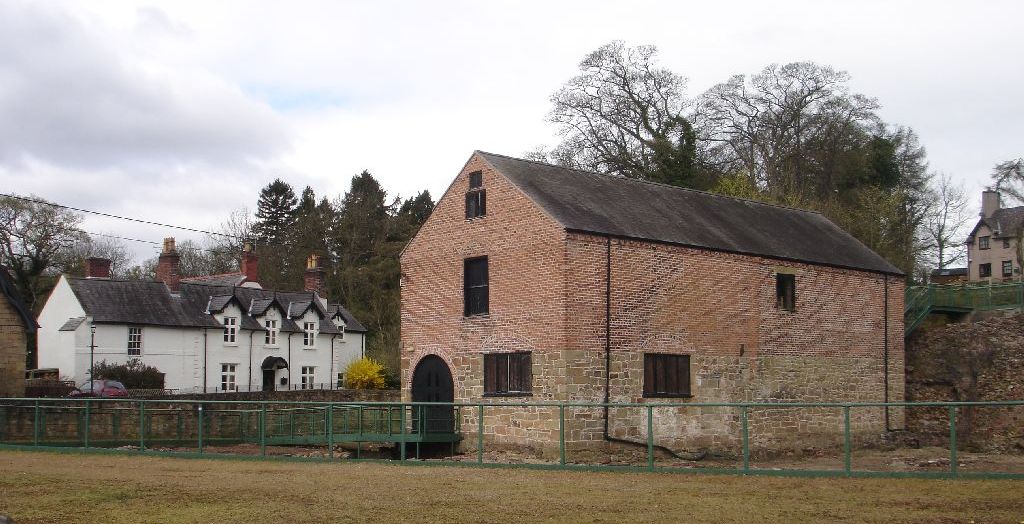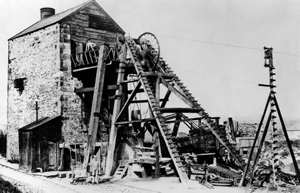|
River Clywedog
The River Clywedog is a river in Wrexham County Borough, Wales. Its uses have been watering crops, powering industrial machinery but is now used as walking trails or geography trips. The river originates to the west of Wrexham, and joins the River Dee some four miles south east of the city. Course of the river The river Clywedog rises in the hills west of the village of Minera. After flowing through Minera it turns south-east, past Coedpoeth, Bersham and Rhostyllen and through the Erddig Country Park, then east, passing slightly to the south of Wrexham. There is a path along the entire river bank from Minera to Wrexham. After passing the Wrexham industrial estate, the river joins the River Dee near the English/Welsh border. History During the 18th and early 19th centuries there were 17 watermills along the river: fulling mills for preparing cloth, mills for grinding corn and malt, and paper mills. Large waterwheels powered the bellows blasting air into the iron furnaces ... [...More Info...] [...Related Items...] OR: [Wikipedia] [Google] [Baidu] |
Welsh Language
Welsh ( or ) is a Celtic language family, Celtic language of the Brittonic languages, Brittonic subgroup that is native to the Welsh people. Welsh is spoken natively in Wales, by some in England, and in Y Wladfa (the Welsh colony in Chubut Province, Argentina). Historically, it has also been known in English as "British", "Cambrian", "Cambric" and "Cymric". The Welsh Language (Wales) Measure 2011 gave the Welsh language official status in Wales. Both the Welsh and English languages are ''de jure'' official languages of the Welsh Parliament, the Senedd. According to the 2021 United Kingdom census, 2021 census, the Welsh-speaking population of Wales aged three or older was 17.8% (538,300 people) and nearly three quarters of the population in Wales said they had no Welsh language skills. Other estimates suggest that 29.7% (899,500) of people aged three or older in Wales could speak Welsh in June 2022. Almost half of all Welsh speakers consider themselves fluent Welsh speakers ... [...More Info...] [...Related Items...] OR: [Wikipedia] [Google] [Baidu] |
Wrexham Industrial Estate
Wrexham Industrial Estate (Welsh: ) is a well defined industrial area in Wrexham. It is sited on the eastern outskirts of the city and 2.5 miles from the centre of Wrexham. Originally the site of a World War II munitions factory, the estate later became known as the Wrexham Trading Estate. It has now grown to cover approximately and the largest industrial estate in Wales, second in the UK after Trafford Park, and one of the largest industrial estates in Europe. There are around 300 businesses, providing employment for approximately 8,000 people The estate consists of standalone industrial sites, industrial estates and business parks. The estate is the location of the UK's largest prison, HM Prison Berwyn which opened in 2017. ROF Wrexham The Wrexham Industrial Estate had its origins as a Royal Ordnance Factory, ROF Wrexham, during World War II. The site employed 13,000 workers.B.A.Malaws, RCAHMW, 2003-08-2Retrieved 2011-01-05) The factory made cordite, an explosive propellant ... [...More Info...] [...Related Items...] OR: [Wikipedia] [Google] [Baidu] |
Bersham Ironworks
Bersham Ironworks were large ironworks at Bersham, near Wrexham, Wales. They are most famous for being the original working site of John Wilkinson. They were also the first site in the world to use a new way of boring holes in cannon and steam engine cylinders. History Ironworking began at Bersham around 1640, and evidence shows that the cannon for the Royalists in the English Civil War were made there. In the 18th century, Isaac Wilkinson bought the ironworks and ran it for a considerable number of years. The main product was cannon, although the process to make them in iron was difficult, and cannonballs often became stuck in the barrel, leading to explosions. When Isaac's son John Wilkinson took over, he employed a boring machine to accurately make a smooth bore cannon, which became so popular that cannons produced using this technique were used in the American War of Independence and the Napoleonic wars. As well as cannon, the smooth bore machine could make cylinders for B ... [...More Info...] [...Related Items...] OR: [Wikipedia] [Google] [Baidu] |
Minera Leadmines
The Minera Lead Mines were a mining operation and are now a country park and tourist centre in the village of Minera near Wrexham, in Wrexham County Borough, Wales. History The first written record of lead mining at Minera dates back to 1296, when Edward I of England hired miners from the site to work in his new mines in Devon. Not all of them vacated the area, however, as mining went on until the Black Death in 1349, when it ended. In 1527, two men bought the rights to mine on the site, but deeper workings were unworkable due to the presence of underground rivers, and the inability to prevent flooding. The inability to pay for steam engines to pump out water closed the mines again until 1845, when John Taylor & Sons, mining agents from Flintshire, formed the Minera Mining Company. They were able to build a stationary steam engine on site, and also blast caves from down in the valley into the mines, for extra drainage. The steam engine was a Cornish engine (i.e. a Beam eng ... [...More Info...] [...Related Items...] OR: [Wikipedia] [Google] [Baidu] |
Deindustrialization
Deindustrialization is a process of social and economic change caused by the removal or reduction of industrial capacity or activity in a country or region, especially of heavy industry or manufacturing industry. There are different interpretations of what deindustrialization is. Many associate American deindustrialization with the mass closing of automaker plants in the now so-called "Rust Belt" between 1980 and 1990. The US Federal Reserve raised interest and exchange rates beginning in 1979, and continuing until 1984, which automatically caused import prices to fall. Japan was rapidly expanding productivity during this time, and this decimated the US machine tool sector. A second wave of deindustrialization occurred between 2001 and 2009, culminating in the automaker bailout of GM and Chrysler. Research has pointed to investment in patents rather than in new capital equipment as a contributing factor.Kerwin Kofi Charles et al (201The Transformation of Manufacturing an ... [...More Info...] [...Related Items...] OR: [Wikipedia] [Google] [Baidu] |
Woodland
A woodland () is, in the broad sense, land covered with trees, or in a narrow sense, synonymous with wood (or in the U.S., the ''plurale tantum'' woods), a low-density forest forming open habitats with plenty of sunlight and limited shade (see differences between British, American, and Australian English explained below). Woodlands may support an understory of shrubs and herbaceous plants including grasses. Woodland may form a transition to shrubland under drier conditions or during early stages of primary or secondary succession. Higher-density areas of trees with a largely closed canopy that provides extensive and nearly continuous shade are often referred to as forests. Extensive efforts by conservationist groups have been made to preserve woodlands from urbanization and agriculture. For example, the woodlands of Northwest Indiana have been preserved as part of the Indiana Dunes. Definitions United Kingdom ''Woodland'' is used in British woodland management to mean tre ... [...More Info...] [...Related Items...] OR: [Wikipedia] [Google] [Baidu] |
Ironworks
An ironworks or iron works is an industrial plant where iron is smelted and where heavy iron and steel products are made. The term is both singular and plural, i.e. the singular of ''ironworks'' is ''ironworks''. Ironworks succeeded bloomeries when blast furnaces replaced former methods. An integrated ironworks in the 19th century usually included one or more blast furnaces and a number of puddling furnaces or a foundry with or without other kinds of ironworks. After the invention of the Bessemer process, converters became widespread, and the appellation steelworks replaced ironworks. The processes carried at ironworks are usually described as ferrous metallurgy, but the term siderurgy is also occasionally used. This is derived from the Greek words ''sideros'' - iron and ''ergon'' or ''ergos'' - work. This is an unusual term in English, and it is best regarded as an anglicisation of a term used in French, Spanish, and other Romance languages. Historically, it is common ... [...More Info...] [...Related Items...] OR: [Wikipedia] [Google] [Baidu] |
Industrial Revolution
The Industrial Revolution was the transition to new manufacturing processes in Great Britain, continental Europe, and the United States, that occurred during the period from around 1760 to about 1820–1840. This transition included going from hand production methods to machines, new chemical manufacturing and iron production processes, the increasing use of steam power and water power, the development of machine tools and the rise of the mechanized factory system. Output greatly increased, and a result was an unprecedented rise in population and in the rate of population growth. Textiles were the dominant industry of the Industrial Revolution in terms of employment, value of output and capital invested. The textile industry was also the first to use modern production methods. The Industrial Revolution began in Great Britain, and many of the technological and architectural innovations were of British origin. By the mid-18th century, Britain was the world's leadi ... [...More Info...] [...Related Items...] OR: [Wikipedia] [Google] [Baidu] |
Paper Mill
A paper mill is a factory devoted to making paper from vegetable fibres such as wood pulp, old rags, and other ingredients. Prior to the invention and adoption of the Fourdrinier machine and other types of paper machine that use an endless belt, all paper in a paper mill was made by hand, one sheet at a time, by specialized laborers. History Historical investigations into the origin of the paper mill are complicated by differing definitions and loose terminology from modern authors: Many modern scholars use the term to refer indiscriminately to all kinds of mills, whether powered by humans, by animals or by water. Their propensity to refer to any ancient paper manufacturing center as a "mill", without further specifying its exact power source, has increased the difficulty of identifying the particularly efficient and historically important water-powered type. Human and animal-powered mills The use of human and animal powered mills was known to Muslim and Chinese paperma ... [...More Info...] [...Related Items...] OR: [Wikipedia] [Google] [Baidu] |
Fulling Mill
Fulling, also known as felting, tucking or walking ( Scots: ''waukin'', hence often spelled waulking in Scottish English), is a step in woollen clothmaking which involves the cleansing of woven or knitted cloth (particularly wool) to eliminate (lanoline) oils, dirt, and other impurities, and to make it shrink by friction and pressure. The work delivers a smooth, tightly finished fabric that is isolating and water repellent. Well known example are duffel cloth, first produced in Flanders in the 14th century and loden, produced in Austria from the 16th century on. The practice to do this by hand or feet died out with the introduction of machines during the industrial revolution. Process Fulling involves two processes: scouring and milling (thickening). Originally, fulling was carried out by the pounding of the woollen cloth with a club, or the fuller's feet or hands. In Scottish Gaelic tradition, this process was accompanied by waulking songs, which women sang to set the ... [...More Info...] [...Related Items...] OR: [Wikipedia] [Google] [Baidu] |









